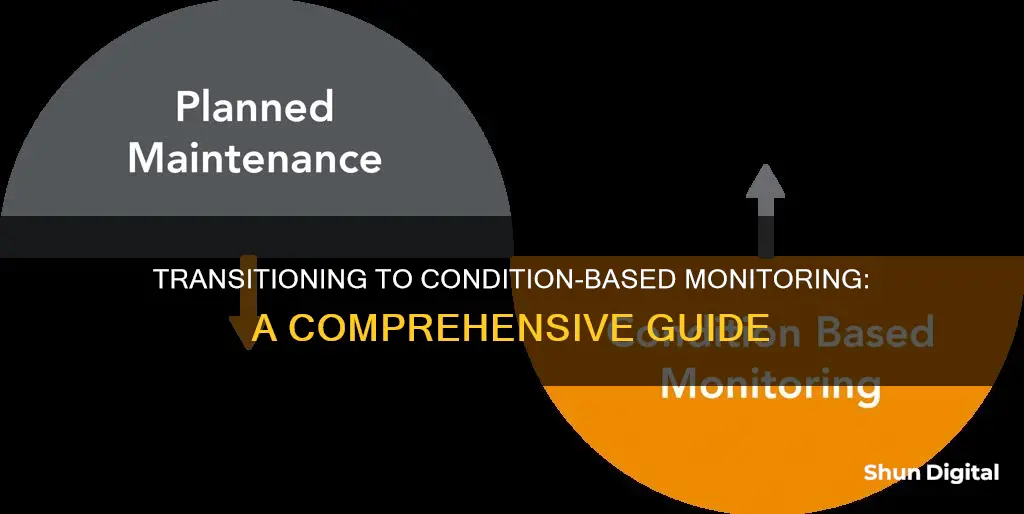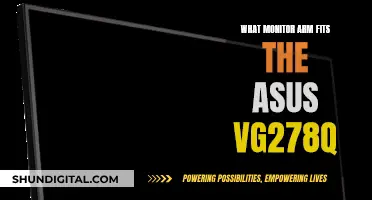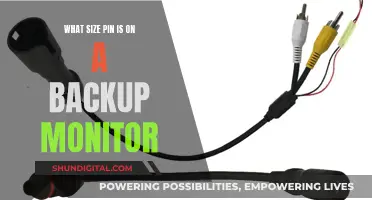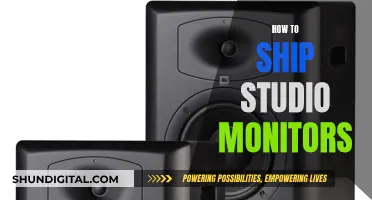
Condition-based monitoring (CBM) is a maintenance strategy that monitors the current condition of an asset and uses data to decide what maintenance needs to be done to ensure peak asset health. It is a proactive approach that continuously monitors equipment and systems to detect potential faults or deviations from normal operating conditions. By doing so, CBM helps to reduce costs, improve efficiency, and prevent equipment failure. This involves the collection and analysis of data from various sensors and devices placed on equipment to measure parameters such as vibration, temperature, and pressure. This data is then compared with historical trends to identify anomalies and potential issues, triggering alerts to inform maintenance personnel and allowing for timely maintenance actions. CBM has been proven to be highly effective and reliable across multiple industries, offering a range of advantages over traditional maintenance approaches.
What You'll Learn
- Identify critical equipment and parameters based on importance, failure data and maintenance goals
- Choose appropriate monitoring technology and sensors compatible with existing equipment
- Place sensors strategically on equipment following guidelines and best practices
- Implement a data collection system for regular or real-time sensor readings
- Set baseline values and thresholds for each parameter

Identify critical equipment and parameters based on importance, failure data and maintenance goals
Identifying critical equipment and parameters is a crucial step when switching to condition-based monitoring. This process involves evaluating equipment based on its importance, failure data, and maintenance goals to determine which assets require close monitoring to prevent costly breakdowns and optimise maintenance practices. Here are some key considerations for this step:
Importance of Equipment
When identifying critical equipment, it is essential to consider the impact of potential failures on the overall production process and plant safety. Some equipment may be vital to the plant's operation, and their failure could result in significant economic setbacks and production losses. For example, in a power plant, critical machinery could include steam or gas turbines, while in an oil rig, it could be crude oil export pumps.
Failure Data Analysis
Analysing failure data helps identify equipment prone to breakdowns or malfunctions. This analysis can include historical data on the frequency and nature of failures, such as the number of failures, average time to restore failed equipment, and the expected lifespan of the equipment. By understanding which equipment has a higher failure rate, organisations can prioritise monitoring and maintenance efforts.
Maintenance Goals
Maintenance goals play a crucial role in determining which equipment and parameters to focus on for condition-based monitoring. The primary goal of condition monitoring is to detect potential faults or deviations from normal operating conditions to prevent equipment failure and costly downtime. Therefore, it is essential to identify the parameters that, when monitored, will provide early warning signs of potential issues. These parameters may include vibration, temperature, pressure, electrical signals, and more, depending on the specific equipment.
Risk Assessment
Conducting a criticality analysis or a Failure Modes, Effects, and Criticality Analysis (FMECA) can help assess the potential risks associated with equipment failure. This analysis involves assigning a criticality ranking to each asset based on the potential impact of its failure on operations. By understanding the criticality of each piece of equipment, organisations can prioritise their condition monitoring efforts and select the most appropriate monitoring technology.
Cost-Benefit Analysis
When identifying critical equipment and parameters, it is essential to consider the cost-benefit analysis of implementing condition monitoring. While condition monitoring can provide valuable insights, it also incurs costs for sensor purchase and installation, employee training, and potential sensor replacement due to harsh operating conditions. Therefore, organisations should evaluate the financial implications to ensure the benefits outweigh the costs.
Environmental Factors
The operating environment of the equipment is another crucial consideration. Condition monitoring sensors are delicate and may be susceptible to damage from extreme temperatures, corrosive substances, or other environmental factors. Additionally, it may be challenging to mount sensors on hard-to-reach equipment, such as submersible borehole pumps. Therefore, it is essential to select sensors that are compatible with the equipment's environment and easily accessible for installation and maintenance.
In summary, identifying critical equipment and parameters for condition-based monitoring involves evaluating the importance of equipment, analysing failure data, understanding maintenance goals, conducting risk assessments, considering cost-benefit analysis, and taking into account the equipment's operating environment. By carefully considering these factors, organisations can effectively implement condition-based monitoring to optimise maintenance practices and prevent costly equipment failures.
Switching Graphics Cards Without a Monitor: A Step-by-Step Guide
You may want to see also

Choose appropriate monitoring technology and sensors compatible with existing equipment
Choosing the right monitoring technology and sensors is critical to the success of a condition-based monitoring (CBM) system. The following are some key considerations when selecting monitoring technology and sensors compatible with existing equipment:
Compatibility with Existing Equipment
Ensure that the sensors and monitoring technology are compatible with the machines you plan to monitor. Some modern machines may have built-in monitoring components, but for older machines, retrofitting with specialized instruments is often possible and more cost-effective than upgrading. Sensors should be chosen to measure the correct variables without interfering with the machine's operation.
Type of Sensors
There are various types of sensors available, including vibration, temperature, sonic (microphone), and machine vision sensors. Vibration sensors are the most common, as vibration is a reliable indicator of imminent machine failure. Temperature sensors are useful for machines operating under heavy loads or extreme conditions. Sonic sensors can detect sound frequencies, including vibrations and grinding sounds indicating lubrication issues. Machine vision systems use cameras to visually inspect equipment and identify faults, which is useful for stationary equipment or remote/dangerous locations.
Wired vs. Wireless Sensors
Consider the advantages and disadvantages of wired vs. wireless sensors. Wireless sensors offer flexibility in placement and are easier to install, especially for rotary motion equipment. Wired sensors may be more stable and reliable for data transmission but are less suitable for moving parts and require more complex installation.
Sensor Capabilities
Not all sensors capture or report the same information. Some sensors may only capture Overall Value (OA), which is a measure of vibration at the sensor, and may not provide detailed diagnostic information. Other sensors capture a full-time waveform (TWF), which can help diagnose problems and inform timely maintenance strategies.
Installation and Maintenance Requirements
Consider the installation and maintenance requirements of the sensors and monitoring technology. Wireless sensors are generally easier to install, but ensure you understand the specific requirements from your supplier. In-depth technical knowledge and trained staff are necessary for the installation, maintenance, and interpretation of sensor data.
Power Source
Choose between battery-powered wireless sensors (replaceable or non-replaceable) or standard power cord connections. Battery-powered sensors offer more flexibility in placement, but consider the replacement/recharging requirements.
Data Collection and Transmission
Determine how the sensor data will be collected and transmitted. Wired sensors can connect to transponders that beam data wirelessly or via cables to a central processing unit. Long-range wireless transmission can also be achieved using GSM modules and cellular networks, or Mesh Wi-Fi networks in large facilities.
Data Analysis
Ensure you have the necessary data analytics capabilities to process and interpret the sensor data. This can be done in-house or outsourced to cloud computing providers. Data analytics software can detect patterns, identify anomalies, and alert maintenance teams when specific conditions are met.
By carefully considering these factors, you can choose the appropriate monitoring technology and sensors that are compatible with your existing equipment, enabling effective condition-based monitoring and maintenance.
Monitoring Memory Usage: NRPE Nagios Guide
You may want to see also

Place sensors strategically on equipment following guidelines and best practices
When placing sensors on equipment, there are several guidelines and best practices to follow to ensure optimal data collection and accuracy. Here are some key considerations for strategic sensor placement:
- Consider the monitoring goals: Understand the specific parameters you want to measure and the equipment's functionality. Different equipment will have varying ideal locations for sensor placement. For example, a sensor monitoring emissions from idling buses will be placed differently from one estimating the local ambient air quality index.
- Accessibility: Ensure easy access to the sensors for installation, maintenance, and periodic checks. If the site is not under your control, establish permissions, access requirements, and any limitations beforehand.
- Power sources: Sensors may require a power source, such as being plugged into an outlet or utilising solar panels. Consider the power options available at the installation site and how they may impact sensor functionality and data reporting frequency.
- Communication technology: Sensors communicate data using various technologies like cellular, WiFi, or LoRa. Understand the specific requirements of the sensors, including network limitations, carrier limitations, area coverage, and signal strength needs.
- Security: Sensors are susceptible to tampering and theft. Mount sensors in secure locations, such as overhead out of arm's reach, in inconspicuous locations, or behind locked gates or fences. Also, consider your physical safety when accessing the sensors.
- Placement height: Ideally, place sensors near the typical breathing zone height, which is usually between 3 to 6 feet. This height range provides a more representative measure of air quality and equipment performance.
- Distance from equipment: Place sensors close enough to the equipment to detect fluctuations accurately but avoid mounting them on surfaces subject to vibration as it could damage the sensors. Anchor sensors to walls or firm bases instead.
- Airflow considerations: Ensure sensors are positioned to allow free airflow without obstruction from surrounding structures, equipment, or vegetation. Place them away from pollutant sources or sinks to prevent biased or noisy measurements.
- Temperature and sunlight: Avoid placing sensors in direct sunlight or near heat sources, as this can interfere with temperature measurements and sensor accuracy.
- Maintenance and inspection: Mount sensors in accessible locations to facilitate easy maintenance and inspection. This is particularly important for sensors requiring regular maintenance, such as solar panels, which need periodic cleaning to remove dust.
By following these guidelines and considering the specific equipment and sensors involved, you can strategically place sensors to optimise data collection, accuracy, and equipment performance while also ensuring the longevity and quality of the sensors themselves.
Rotating LCD Monitors: Any Risks Involved?
You may want to see also

Implement a data collection system for regular or real-time sensor readings
To implement a data collection system for regular or real-time sensor readings, you can follow these steps:
- Establish a conditional baseline: Before installing sensors, it is important to establish a baseline for the performance and condition of the asset or equipment. This baseline will serve as a reference point for future data collection and analysis.
- Install sensors for CBM: Choose and install the appropriate sensors for condition-based monitoring (CBM). These sensors will collect data on various parameters such as vibration, temperature, pressure, and more. Sensors can be installed on rotating equipment like compressors, pumps, and motors, as well as on other critical assets.
- Collect condition data: With the sensors in place, start collecting condition data at specific intervals or continuously, depending on the nature of the equipment and the parameters being monitored. This data will provide insights into the performance and health of the assets.
- Analyse the data: Utilize data collection and analysis software to process the sensor readings. Compare the real-time performance data against the established baseline and historical performance data to identify any deviations or abnormalities.
- Set up performance alerts: Define the acceptable ranges for each parameter being monitored. Set up alerts or notifications that will be triggered when the sensors detect values outside of these acceptable ranges. These alerts will help maintenance teams respond promptly to potential issues.
- Integrate with maintenance systems: Ensure that the data collection system can integrate with computerized maintenance management systems (CMMS) or other maintenance platforms. This integration will enable maintenance teams to receive alerts and access real-time data, allowing them to make informed decisions and take appropriate maintenance actions.
- Implement a feedback loop: Continuously evaluate the effectiveness of the data collection system and maintenance actions taken. Use the insights gained from each maintenance event to optimize the data collection process and fine-tune the maintenance strategies.
By following these steps, organizations can effectively implement a data collection system for condition-based monitoring, enabling them to make data-driven decisions, improve asset reliability, and reduce unplanned downtime.
Choosing a Monitor for Better Viewing with Poor Eyesight
You may want to see also

Set baseline values and thresholds for each parameter
Setting baseline values and thresholds for each parameter is a crucial step in condition monitoring. This process involves defining the normal operating range for each measured parameter, such as vibration, temperature, pressure, and electrical signals. Baselines are established by collecting data over a specified time period, typically a week or more, to ensure reliability.
To set baseline values, start by identifying the critical parameters that need to be monitored for specific equipment. For example, in motor condition monitoring, critical parameters include vibration, temperature, and electrical parameters. Then, collect data for these parameters over a sufficient period to capture any variations and establish a normal operating range. This data collection process can be done in real-time or at regular intervals, depending on the monitoring system.
When setting thresholds, it's important to consider both static and dynamic approaches. Static thresholds are fixed values that represent the limits of acceptable performance. For instance, a server with a CPU utilisation of over 90% is generally unacceptable. On the other hand, dynamic thresholds are intelligent and learn what is normal for the environment, sending alerts only when there are deviations from these understood cycles and parameters. Dynamic thresholds are particularly useful for identifying daily, weekly, monthly, or even annual cycles in IT systems.
Additionally, when setting thresholds, you can define the severity levels of alerts, such as critical, major, minor, or informational. This helps prioritise and categorise the alerts generated by the condition monitoring system. The severity level of an alert can also be determined by the administrator when setting thresholds.
By setting baseline values and thresholds, condition monitoring systems can accurately identify anomalies, patterns, and deviations from normal operating conditions. This enables proactive maintenance, early fault detection, and timely maintenance actions, ultimately improving equipment reliability and performance.
Troubleshooting Guide: Identifying a Dead Monitor
You may want to see also
Frequently asked questions
Condition-based monitoring (CBM) is a maintenance strategy that involves the continuous monitoring of equipment and systems to detect potential faults or deviations from normal operating conditions.
Condition-based monitoring helps to reduce costs, increase equipment lifespan, minimise disruptions to normal operations, improve asset and equipment reliability, and reduce downtime due to unexpected failures.
The key elements of condition-based monitoring include sensor placement, data collection, data analysis, alert generation, maintenance planning, and continuous improvement.
Condition-based monitoring uses sensors to collect data on various parameters such as vibration, temperature, pressure, and electrical signals. This data is then analysed to identify anomalies, patterns, or indicators of potential issues. Alerts are generated when potential faults are detected, triggering maintenance actions.







